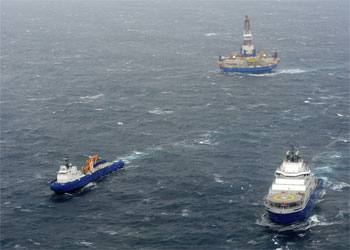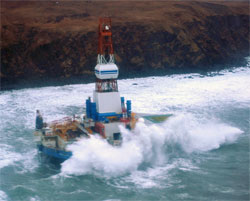A conical drilling unit being towed out of Alaska in near-hurricane conditions broke loose from tugboats and ran aground near Kodiak.
The Royal Dutch Shell drill rig Kulluk beached along Sitkalidak Island on Dec. 31, 2012. Four tugboats had taken turns struggling to control it. It initially was being towed by new anchor-handler Aiviq, whose four engines failed three days earlier in an incident attributed to contaminated fuel.
Kulluk was en route from Dutch Harbor to Seattle for off-season maintenance work when a subtropical cyclone approached. Waves were as high as 40 feet, with 65-mph winds, the U.S. Coast Guard said. The 360-foot icebreaking anchor-handling vessel Aiviq (Ship of the Year, American Ship Review 2013) lost control of the tow.
“The towline … parted on Dec. 27 due to mechanical failure of the tow shackle,” the Alaska Department of Environmental Conservation said in a statement. A connection was quickly regained.
 |
|
The tugs Aiviq and Nanuq tow the mobile drilling unit Kulluk near Kodiak, Alaska, on Dec. 29, the same day that Kulluk’s crew was evacuated by Coast Guard helicopter. |
The next day, however, Aiviq, operated by Edison Chouest Offshore, lost power in all four engines as the vessels were about 50 miles from Kodiak.
“After the loss of propulsion on the Aiviq, we never re-established an ideal connection to the Aiviq,” said Curtis Smith of Shell’s incident command. “It was a series of low-probability events. It was not the result of weather, but it was compounded by weather.”
The cutter Alex Haley attempted to connect a line to the drifting vessels, but the line fouled one of the cutter’s propellers, the Coast Guard said. Two support vessels contracted by Shell, Guardsman and Nanuq, sailed from Seward to assist. First, Guardsman connected to Kulluk, which dropped anchor to slow its drift, according to a statement from the Unified Command. Later, Nanuq connected along with Aiviq. All 18 occupants of Kulluk were evacuated by helicopter.
The tugboat Alert arrived to replace Guardsman as the emergency assist vessel. On Dec. 30, the towlines connecting both Aiviq and Nanuq to Kulluk “separated” and Kulluk went adrift about four miles from land, the Unified Command said. Early Dec. 31, Alert was able to attach to the 400-foot towline that previously had connected Aiviq to Kulluk. Aiviq re-established connection too.
Then Aiviq lost its connection again. Alert was forced to intentionally disconnect, setting the drill unit adrift.
“Kulluk grounded at approximately 9 p.m., Alaska time on the southeast side of Sitkalidak Island,” an Incident Command statement said. “The crew of the tug Alert was ordered to separate from the Kulluk at 8:15 p.m. to maintain the safety of the nine crewmembers aboard the vessel.”
Alert also had propulsion problems at the height of the crisis, said Capt. Paul Mehler III, commander of Coast Guard Sector Anchorage.
“The night of the response … when she was taking maximum power there was an engine problem. They did recover that within 30 minutes,” said Mehler, who didn’t have further details.
Responders could not reach the unmanned Kulluk for days due to the heavy weather. The conical drill unit has a diameter of 266 feet.
“The grounding location in the Ocean Bay area was an extremely high surf area,” said Steve Russell, the state’s on-scene coordinator with the Alaska Department of Environmental Conservation. “The night of the grounding, that was 40-foot seas that were hammering this area.”
Weather conditions improved and connections were re-established, allowing Kulluk to be refloated at high tide Jan. 6 by Smit Salvage.

